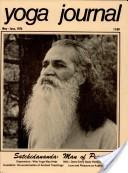I’m quite new to the world of yoga blogging, having overcome what in retrospect seems like a ridiculous amount of fear and trepidation to make my first post only last spring. Once online, however, I quickly discovered a fascinating new world of information, ideas, personalities, debate, and discussion. I was thrilled to find people talking about issues that I’ve been interested in for years, but hadn’t previously had a forum to discuss them in: that is, how yoga is changing, and being changed by its evolving relationship with North American culture.
Lately, however, I’ve been disturbed by my sense that this forum that I’ve only so recently discovered has been spiraling in some negative directions. Particularly in the ongoing
“commercialization of yoga” debate, I’ve noticed more and more comments indicating a sense of division and even animosity. Private conversations have confirmed my sense that feelings have been hurt and relationships damaged.
I don’t think that this is where anyone wants to be. But collective dynamics can take on a life of their own. There may be a group energy that many individuals contribute to, but that no one controls or even necessarily wants.
So I wanted to step back and assess what’s been going on. I wonder:
- If you’ve been involved in the yoga blogosphere – whether actively or simply as a reader – have you sensed negative dynamics building?
- If so, then what do you think are the root causes of this – and how can they best be addressed?
Since I’ve already answered my first question “yes,” what follows is my take on the second, offered simply as food for thought.
It’s Not a Blame Game
First, however, I want to emphasize that by wondering, “what are the roots of this problem?,” I’m NOT asking “who’s to blame?”
Trying to pin blame on individuals will only generate MORE division and bad feeling. So, if we can’t talk about this other terms other, then it’s best not to talk about it (at least publicly) at all.
I think, however, that it’s possible to talk about negative dynamics in the yoga blogosphere without playing the “blame game.” This may be naïve on my part – but I’m going to give it a shot and see what happens . . .
Working with Fire
My best guess is that the recent sense of division and bad feeling stems from the confluence of two very new developments: 1) the growth of the yoga blogosphere, and 2) the emergence of a new generation of celebrity yoga teachers. Together, this has proven to be a combustible mix. And, when you stop to think about it, it makes complete sense that this would be the case.
I’ll explain why in a minute. But first, let me just note that this sort of fiery mix is not necessarily a bad thing. On the contrary, it can be very good – provided that it’s handled skillfully.

|
| Fire in Yellowstone National Park |
Think of our forests: a raging, out of control fire may be a tragedy, hurting or even destroying a precious natural resource and habitat. At the same time, however, our greatest national parks, like Yellowstone in Wyoming, use
controlled burns for revitalization and renewal. Allowing the forest to burn periodically is nature’s way of clearing old growth, releasing new seeds, creating richer soil, and regenerating the cycle of life. Suppressing all fires completely would paradoxically produce only stagnation, disease, and decay.
In other words, those of us who want to continue discussing yoga and culture shouldn’t seek to avoid controversy and debate. Instead, we should practice working with it skillfully, both for our own benefit and that of the larger community.
In Search of the Cyber Sangha
The blogosphere is a peculiar beast. As my former mentor
Cass Sunstein argues in Republic 2.0, while the Internet provides unprecedented opportunities to connect with different people, it also tends to propel us into more and more polarized camps, where we only talk to those who share our views. Perversely, then, what might ideally be a means of encountering a wide variety of perspectives in order to learn something new all-too-often becomes a means of reinforcing our pre-existing beliefs and prejudices.
Now, the yoga blogosphere is a bit different from the political discussion forums that Sunstein had in mind. People who are interested enough in yoga to read and possibly write about it online already belong to a sizable and diverse, but still niche community. And certainly, in the "real-life" yoga world, it’s easy to find strong connections despite our differences: if I practice
Forrest and you’re dedicated to
Iyengar, for example, we still feel that we're part of the same community (at least in my experience).
The blogosphere, however, has a very different dynamic than face-to-face interaction. Whatever we say online may be read by many, many others, each of whom may have very, very different views about yoga’s real and ideal connection to our larger society and culture.
We can’t immediately see how our interlocutors are reacting to what we’re saying and respond accordingly, the way can in “real life.” We may spout off and hit the “send” button, saying things that we’d never say face-to-face.
Online, we’re limited to the written word, which is a powerful tool that can cut in unanticipated ways.
This means that once controversial topics get introduced, working through them in cyberspace is inherently tricky. The medium itself has polarizing tendencies. While the real-world commonalities of the yoga community counteract that to some degree, a general commitment to
ahimsa (or whatever) is not necessarily sufficient to allow skillful handling of a heated argument if the fire starts raging out of control.
Plus, the yoga blogosphere is relatively new: I’ve only been at it a few months, and even the most prominent bloggers haven’t been at it more than a few years. So there’s no tradition to fall back on. We’re all making this up as we go along.
American Yoga: The Next Generation
Until quite recently, the most influential American-born yoga teachers (e.g., Patrica Walden, Lilias Folan, Richard Freeman, Beryl Bender Birch, and many others) were students of the great 20th century Indian yoga masters (e.g., B.K.S. Iyengar, Pattahbi Jois), either permanently or for some extended period of time.
These teachers also committed to yoga during a time when it wasn’t popular. During the aerobics-crazed 1980s, when most were honing their practice, there was extremely little, if any money or glamor associated with yoga. For quite awhile, in fact, yoga seemed like a quaint, if not embarrassing relic of the now passé hippies-in-search-of-natural-highs or housewives-looking-for-a-little-stretching scenes of the 1960s-70s.
But they preserved. And eventually, a number of them became our well known “celebrity yogis”: Shiva, Baron, Seane, etc. (While these references may be baffling to newbies, believe me, they’re household names if you’ve spent much time in the yoga world.)
Now, however, a new generation of “celebrity” teachers is emerging. Most are quite young, highly attractive, and super-athletic – as well as media-savvy, brand conscious, and corporate-friendly. (Here, I’m thinking of teachers like
Tara Stiles,
Rainbeau Mars, and
Kathryn Budig, all of whom have prominently figured in the recent “commercialization of yoga” debates.) This new generation of teachers is coming into its own in a very different time in the evolution of American yoga – as well as a very different time in American society more broadly.
Today, yoga is much less connected to India, completely disconnected from any sort of counter-culture, and infinitely more popular, glamorous and potentially profitable. Consequently, it’s not surprising that some (although of course, not all) of the leading teachers of this generation have a very different sensibility regarding the how best to negotiate the relationship between yoga and American culture.
The
Nissan endorsements, ,
corporate alliances, , and
weight-loss ads that have generated so much controversy are, I think, all bound up with this generational shift. By pointing out that it’s occurring, I’m not (at least in this post) trying to assess its pros and cons. (And please, let's try to avoid jumping into another "us" versus "them" dynamic, at least for the moment.) Instead, I'm simply noting that it’s happening, and that it’s an important development in the North American yoga community.
“Conflict is Inevitable, Violence is Not”
Put together a new online discussion forum that’s prone to polarization, and a new generation of celebrity yoga teachers representing a different cultural sensibility, and what do you get? Well, for one, fertile ground for conflict.
However, as the
Third Side method of non-violent communication teaches us, “conflict, in itself, is not a bad thing”:
Conflict is a natural and healthy process, necessary for making progress . . . The world may actually need more conflict, not less, if the appropriate skills are known and conflict can be managed productively.
Constructive ways of dealing with conflict involve “debate, dialogue, negotiation, and democracy.” Channeling the energy of controversy and conflict into a productive force requires “a strong container for creative contention”: that is, a collective space that supports “a peaceful, nonviolent process for engaging deep differences, (and) an inclusive outcome that addresses the essential needs of all.”
In the case of the yoga blogosphere, I believe that the outcome that we need is NOT resolution of our substantive differences: I don’t think that we can or will come to agreement about the core issues at stake in the “commercialization of yoga” debates. Rather, we need to turn the yoga blogosphere into a resource that can support everyone in their practice by providing a space to connect with different people and viewpoints – some of which we won't agree with or may even find upsetting – and grow, both individually and collectively, in the process.
















